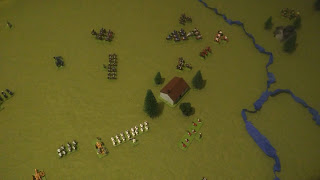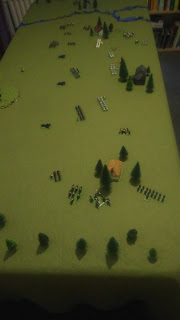The Prussian army consists of King Frederick (rated exceptional), seven battalions of regular foot, 1.5 battalions of grenadiers, one unit of jäger, four squadrons of cuirassiers, four squadrons of dragoons, two squadrons of hussars and three guns.
The Austrian army consists of Prince Charles, 10 battalions of regular foot, one battalion of grenadiers, one unit of grenzer (light infantry), three squadrons of cuirassiers, one other squadron of heavy horse, five squadrons of dragoons and other medium horse, two squadrons of hussars and three guns.
 |
| Overview of the battlefield as dawn breaks with the armies already very close to each other |
 |
| Looking from behind Pilgramshain and the Austro-Saxon left |
 |
| Looking from behind Günthersdorf in the centre |
 |
| The situation on the Austro-Saxon right |
For a battle not involving British troops, Hohenfriedberg is surprisingly well-covered in English-language publications.
As usual I will be relying mainly on the accounts of two historians: Thomas Carlyle, who walked the battlefield while preparing his biography of Frederick, and Reed Browning, whose book The War Of The Austrian Succession came out in 1993. There is also a short account on Wikipedia, a surprisingly full one at BritishBattles.com and another one online at
https://en.wikisource.org/wiki/1911_Encyclop%C3%A6dia_Britannica/Hohenfriedberg
All the units on my battlefield are Pendraken figures painted in the uniforms of the three countries, and in several cases I have managed to put regiments in more-or-less their exact positions on the battlefield.
For example in a prominent position on the Austrian right are the Hohen-Ems Cuirassiers and Sachsen-Gotha Dragoons, whose defeat by Prussian horse led to the wounding and capture of an Austrian commander, General von Berlichengen, who was later reprimanded by Frederick, tongue-in-cheek it would seem, for verbally abusing his captors.
 |
| In the front line of Austrian horse beside the hamlet of Thomaswaldau are the Hohen-Ems Cuirassiers (right) and the Sachsen-Gotha Dragoons (left), and between them are the Liechtenstein Dragoons |
The battle is considered to have been quite a close affair until the Bayreuth Dragoons, an oversized regiment of 10 squadrons, held back in the centre for just such a moment, charged into a gap in the Austrian infantry line and began a general rout.
 |
| Frederick, on a grey charger, can be seen attached to the Bayreuth Dragoons in the rear |
Victory in our refight, in which I will be up against my regular wargames opponent in our continuing campaign of recreating the War of the Austrian Succession, will be decided as usual on army points.
The relevant rule in Game Of Kings reads: "Total each side's army points at the start of a battle using 3pts for a general, 2pts for a foot battalion and 1pt for each other unit (including light infantry) ... an army loses when its army points fall below half the starting total."
In this case, Frederick's half-battalion of grenadiers on the Prussian right will count as an 'other unit'. So the Prussian army points are: Frederick (3), seven battalions of regular foot (14), 1.5 battalions of grenadiers (3), one unit of jäger (1), four squadrons of cuirassiers (4), four squadrons of dragoons (4), two squadrons of hussars (2) and three guns (3). That is a total of 34pts.
The Austro-Saxon army points are: Charles (3), 10 battalions of regular foot (20), one battalion of grenadiers (2), one unit of grenzer (1), three squadrons of cuirassiers (3), one other squadron of heavy horse (1), five squadrons of dragoons and other medium horse (5), two squadrons of hussars (2) and three guns (3). That is a total of 40pts.
Prussian foot, excepting the jägers, get a +1 modifier for musketry throws.
Grenadiers in both armies count as elite, as does Prussia's Garde du Corps cuirassiers, who are on Frederick's right supporting the attack on the Saxons, and Austria's Modena Cuirassiers, who are in reserve with Charles behind Thomaswaldau.
The river can only be forded by cavalry, and it takes them a complete turn.
The hamlets played little part in the battle - they were apparently too insignificant, among so many troops. to be garrisoned. Accordingly they provide no cover but do affect line-of-sight. and they slow movement by half.
Charles's forces were somewhat demoralised by the realisation they had been caught on the hop - not for the first time - by their enemy. Frederick has the initiative for the first five turns, which gives him the right to go first or second in those turns, and any Austro-Saxon unit having to take a morale test in those turns suffers a -1 modifier.
By the way, reports of the sizes of the two armies nearly always show the Prussians having a huge preponderance in artillery. This is usually the case in the War of the Austrian Succession, but it is because the numbers include tiny battalion guns which were given to Prussian infantry. It is partly to account for these that I give Prussian infantry a +1 modifier (but the main reason is that Prussian foot were the best in Europe).






















































